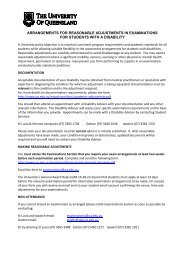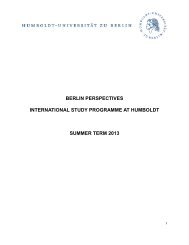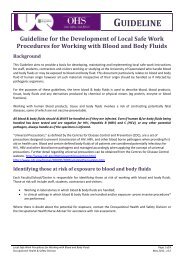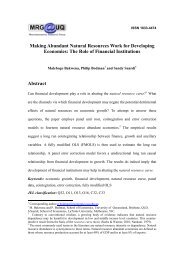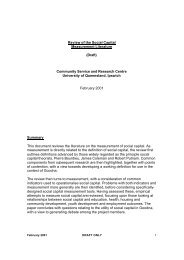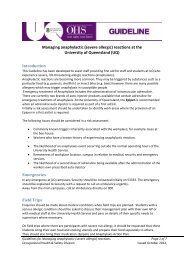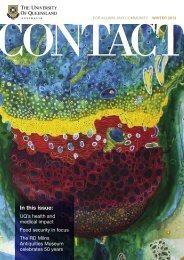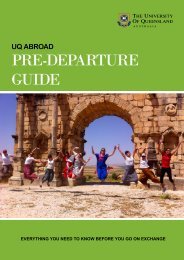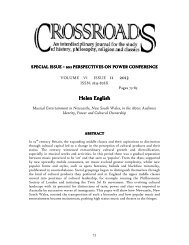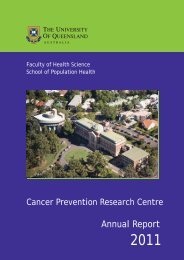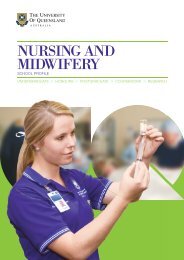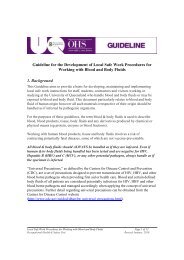Memmott, Paul and Chambers, Catherine - University of Queensland
Memmott, Paul and Chambers, Catherine - University of Queensland
Memmott, Paul and Chambers, Catherine - University of Queensland
Create successful ePaper yourself
Turn your PDF publications into a flip-book with our unique Google optimized e-Paper software.
HOMELESSNESS AMONGST ABORIGINALPEOPLE IN INNNER SYDNEYDr <strong>Paul</strong> <strong>Memmott</strong> <strong>and</strong> <strong>Catherine</strong> <strong>Chambers</strong><strong>University</strong> <strong>of</strong> Queensl<strong>and</strong>
ABSTRACTThis paper reports on some <strong>of</strong> the findings <strong>of</strong> the Inner-City Sydney Aboriginal Homeless ResearchProject which was commissioned by the NSW Government's Aboriginal Housing Office in 2004 as apart <strong>of</strong> the Partnership Against Homelessness initiative. The brief portrait provided here <strong>of</strong> theAboriginal homeless <strong>of</strong> inner-city Sydney <strong>and</strong> the factors that have influenced their situation drawson interviews with 53 homeless Aboriginal people contained in a consultation report prepared by theauthors <strong>and</strong> their colleagues at the culmination <strong>of</strong> this project.Homelessness Amongst Aboriginal People in Inner Sydney Page 2
INTRODUCTIONThis paper reports on some <strong>of</strong> the findings <strong>of</strong> the Inner-City Sydney Aboriginal HomelessResearch Project, which was commissioned by the New South Wales Government'sAboriginal Housing Office (AHO) as a part <strong>of</strong> the Partnership Against Homelessnessinitiative that was established to “co-ordinate <strong>and</strong> improve a wide range <strong>of</strong> housing <strong>and</strong>support services for homeless people" (NSW, Dept <strong>of</strong> Housing, 2002). The brief portraitprovided here <strong>of</strong> the Aboriginal homeless <strong>of</strong> inner-city Sydney <strong>and</strong> the factors that haveinfluenced their situation draws on a consultation report prepared by the authors <strong>and</strong> theircolleagues at the culmination <strong>of</strong> this project (<strong>Memmott</strong>, <strong>Chambers</strong>, Pitts, Green & Ingram2005). It also builds on previous research on Australian Indigenous homelessnessconducted by the authors <strong>and</strong> other colleagues, which has sought to develop aclassification <strong>of</strong> types <strong>of</strong> Indigenous homelessness <strong>and</strong> evaluate the success <strong>of</strong> a range <strong>of</strong>service responses to the issue.Small groups <strong>of</strong> Indigenous people living in public places continue to be a significantsource <strong>of</strong> conflict in many urban centres around Australia. <strong>Memmott</strong>’s research intoaspects <strong>of</strong> Indigenous homelessness began in the early to mid 1990s, firstly in AliceSprings among its informal river campers, <strong>and</strong> then with Aboriginal visitors to the HallsCreek community (<strong>Memmott</strong> 1990, 1991A & B, 1993). More recently, an intense researchproject was carried out for a partnership <strong>of</strong> cross-jurisdictional government <strong>and</strong> Aboriginalagencies in the Northern Territory on the Aboriginal public place dwellers (or ‘LongGrassers’) <strong>of</strong> the Darwin area <strong>and</strong> a strategic review undertaken <strong>of</strong> program responses totheir itinerant lifestyles (<strong>Memmott</strong> & Fantin 2001), part <strong>of</strong> which involved a limitedliterature analysis <strong>of</strong> the subject. Following this in 2002 the Commonwealth Department<strong>of</strong> Families <strong>and</strong> Community Services provided a small grant to complete a nationaloverview <strong>of</strong> response strategies to Indigenous homelessness (<strong>Memmott</strong>, Long &<strong>Chambers</strong> 2003). The aim was to canvas a wide repertoire <strong>of</strong> techniques <strong>and</strong> approachesin order to raise awareness as well as provoke debate among service providers <strong>and</strong> policymakers. Through 2003 <strong>and</strong> 2004 a number <strong>of</strong> papers were prepared with funding from theAustralian Housing <strong>and</strong> Urban Research Institute, the focus <strong>of</strong> which was to develop a list<strong>of</strong> categories <strong>of</strong> Indigenous homelessness based on identified needs <strong>and</strong> assess how anaccurate typology should inform improved service provision. It also included an overview<strong>of</strong> government policy with regards homelessness (<strong>Memmott</strong>, Long, <strong>Chambers</strong> & Spring2003). This categorisation has informed the work discussed here <strong>and</strong> is summarised in thefollowing Table.TABLE 1: CATEGORIES OF INDIGENOUS ‘HOMELESS’ PEOPLENote: These are not mutually exclusive categories. (Adapted from <strong>Memmott</strong> et al 2004: Table 2.1.)1. PUBLIC PLACE DWELLERS. Living in a mix <strong>of</strong> public or semi-public places (as well assome private places, which are entered illegally for overnightshelter) eg parks, churches, ver<strong>and</strong>ahs, carparks, car salesyards (under cars), beaches, drains, riverbanks, vacant lots,dilapidated buildings.1.1 Public place dwellers – voluntary, short-termintermittent.1.2 Public place dwellers – voluntary, mediumterm.These people are <strong>of</strong>ten staying in conventionalaccommodation (eg a relative’s house) <strong>and</strong> may have theirown residence in a rural or remote settlement. When theysocialise in public urban places, they may or may not decideto camp out overnight, usually with others, despite theavailability <strong>of</strong> accommodation.Residing continually in public places (including overnight);acknowledge they have another place <strong>of</strong> residence in a homecommunity but uncertain if <strong>and</strong> when they will return.Homelessness Amongst Aboriginal People in Inner Sydney Page 1
1.3 Public place-dwellers – voluntary, long-term(chronic homeless).1.4 Public place-dwellers - Reluctant <strong>and</strong> bynecessity.Residing continually in public places (including overnight); itis unclear whether it is possible for such individuals toreadily reconcile with their home community/family due to arange <strong>of</strong> emotional barriers; they have come to regard a beat<strong>of</strong> public places as their ‘home’.Residing continually in public places, <strong>and</strong> who(a)Wish to return home but need to remain in an urbanarea due to a service need or to support a hospitalizedrelative or similar; or(b)(c)Wish to return home but no funds for travel <strong>and</strong>/orcapacity to organize travel; orAre waiting for public rental housing to becomeavailable.2.0 THOSE AT RISK OF HOMELESSNESS(HIDDEN HOMELESSNESS)At risk <strong>of</strong> losing house or <strong>of</strong> losing the amenity <strong>of</strong> house.2.1 Insecurely housed people. Residing in adequate housing but under threat <strong>of</strong> losing it;lack <strong>of</strong> secure tenure; possibly due to circumstances <strong>of</strong>poverty.2.2 People in sub-st<strong>and</strong>ard housing. Persons whose housing is <strong>of</strong> a sub-st<strong>and</strong>ard architecturalquality, possibly unsafe or unhealthy housing [but thest<strong>and</strong>ards need to be defined – the issue <strong>of</strong> culturalst<strong>and</strong>ards.]2.3 People experiencing crowded housing. Persons whose housing is crowded [but crowding should bedefined as involving considerable stress (<strong>and</strong> not ascertainedby density measures alone).]2.4 Dysfunctionally mobile persons. In a state <strong>of</strong> continual or intermittent residential mobilityincluding temporary residence (eg crisis accommodation) thatis a result <strong>of</strong> personal <strong>and</strong>/or social problems (eg violence,alcohol <strong>and</strong> substance abuse, lack <strong>of</strong> safety or security in asocial sense, personality or ‘identity crisis’, lack <strong>of</strong> emotionalsupport <strong>and</strong> security).3.0 SPIRITUALLY HOMELESS PEOPLE. A state arising from: (a) separation from traditional l<strong>and</strong>, (b)separation from family <strong>and</strong> kinship networks, or (c) a crisis<strong>of</strong> personal identity wherein one's underst<strong>and</strong>ing orknowledge <strong>of</strong> how one relates to country, family <strong>and</strong>Aboriginal identity systems is confusedIn evolving these three categories <strong>and</strong> their sub-sections <strong>Memmott</strong> <strong>and</strong> his collaboratorshave engaged with the literature on homelessness amongst the general population as wellas the less expansive field focussed on Indigenous homelessness. The definitions used bythe Australian Bureau <strong>of</strong> Statistics in the conduct <strong>of</strong> its censuses <strong>and</strong> that used by theSupported Accommodation Assistance Program, the peak mechanism for Australianservice delivery, were reviewed. The authors found the following works on mainstreamhomelessness most instructive for their discussions <strong>of</strong> culturally appropriate definitions <strong>of</strong>such: Chamberlain (1999), Chamberlain & Johnson (2000) <strong>and</strong> Chamberlain &Mackenzie (1992). Coleman (2000) included in her doctoral thesis, a very useful summary<strong>of</strong> the history <strong>of</strong> mainstream homelessness research. With regards Indigenoushomelessness, the authors reviewed a number <strong>of</strong> reports on groups around Australia. KeysHomelessness Amongst Aboriginal People in Inner Sydney Page 2
& Young (1998) was most wide ranging in the detail <strong>and</strong> depth <strong>of</strong> discussion it provided,while Olive (1992) <strong>and</strong> Berry, MacKenzie, Briskman & Ngwenya (2001) were found tobe useful in elucidating firstly an Indigenous women's perspective, <strong>and</strong> secondly theVictorian context.Of particular relevance to the current authors has been the notion <strong>of</strong> a cultural definition <strong>of</strong>homelessness that uses accepted community st<strong>and</strong>ards to objectively distinguish states <strong>of</strong>homelessness (as expounded by Chamberlain <strong>and</strong> others). We believe that if suchdefinitions were to be evolved for Indigenous Australians, they would have to embrace avery different cultural context: one in which some itinerant people prefer to live in publicplaces on a regular basis, in fact see these places as home <strong>and</strong> hence the term public placedwellers; <strong>and</strong> one in which many more people live in accommodation that puts them atrisk <strong>of</strong> homelessness. Unless service providers recognise these preferences on the oneh<strong>and</strong> <strong>and</strong>, on the other, the true nature <strong>and</strong> extent <strong>of</strong> housing stress amongst Indigenouspeoples, their efforts will continue to fail to some degree. These ideas have formed theframework <strong>of</strong> thinking for this paper.METHODOLOGYThe Aboriginal Housing Company required that the field research be qualitative ratherthan quantitative, incorporating aspects <strong>of</strong> participatory action research <strong>and</strong> narrative datagathering, therefore the approach in the field focussed on encouraging people to tell theirstories in as much detail as possible. This style <strong>of</strong> information gathering, by the Aboriginalfield researchers discussed below, as well as the pace at which work was conducted,resulted in a certain conflation <strong>of</strong> causes <strong>and</strong> symptoms in the field workers’ reports.Although this conflation may seem methodologically problematic to certain critics, wehave taken it as a fieldwork limitation <strong>of</strong> the Indigenous narrative approach.Beside the team in Brisbane, two locally-based field researchers were employed to engagewith the relevant communities <strong>and</strong> identify potential participants over a period <strong>of</strong> sixmonths: these were Mr Richard Greene <strong>of</strong> the Daruk language group <strong>and</strong> Ms Pam Ingram<strong>of</strong> the Wiradjuri language group. Both were long-term residents <strong>of</strong> inner-city Sydney <strong>and</strong>familiar with its Aboriginal community. They had also experienced, <strong>and</strong> indeed as iteventuated were continuing to experience, similar types <strong>of</strong> problems to those theyinterviewed. The field team was led by Ms Angela Pitts, a part-time social planningconsultant to the AHO in Redfern who was also carrying out doctoral research at the<strong>University</strong> <strong>of</strong> Sydney.The scope <strong>of</strong> the project meant that all circumstances reported by the respondents, such asstates <strong>of</strong> substance addiction or mental health issues, were not otherwise verified <strong>and</strong>further explained. As the field researchers were able to establish a rapport withindividuals, the interviewing process could be reflexive, allowing for the incorporation <strong>of</strong>changes as work proceeded <strong>and</strong> new insights emerged into how best to gather <strong>and</strong> analysethe information received.Of the interviews conducted with 53 homeless people, eight were developed intocomprehensive case studies. Two different interview designs were used for public placedwellers <strong>and</strong> those insecurely housed (Refer to Appendix 1 in <strong>Memmott</strong> et al 2005). Inaddition to the one-on-one structured interviews, informal interviewing occurred withstreet groups to aid the field researchers in their pr<strong>of</strong>iling tasks, <strong>and</strong> enable them toexplore more fully such issues as group identity <strong>and</strong> territory or ‘beat’, the types <strong>of</strong>services accessed <strong>and</strong> perceived lifestyle issues.Homelessness Amongst Aboriginal People in Inner Sydney Page 3
THE RESPONDENTSThe field research conducted as part <strong>of</strong> this study revealed that approximately six distinctAboriginal homeless groups or ‘mobs’ operated in the public <strong>and</strong> semi-public places <strong>of</strong>the inner-city <strong>of</strong> Sydney. The members <strong>of</strong> each mob frequently moved between theseplaces, but despite this flexibility, each mob largely operated within a clearly designatedterritory. These individual groups <strong>of</strong>ten seemed to function like a family unit, for examplein looking after one another's safety <strong>and</strong> personal possessions. Each individual identifiedstrongly with his or her group, conforming to its membership rights <strong>and</strong> rituals, <strong>and</strong>involving themselves in other political issues such as leadership, group loyalty <strong>and</strong>resource sharing. When entering or engaging with the different groups, certain protocolswere to be observed.Of the total number <strong>of</strong> homeless persons interviewed during 2004, 37 were public placedwellers <strong>and</strong> 16 were insecurely housed. The majority <strong>of</strong> interviewees were aged between25 <strong>and</strong> 45 years, <strong>and</strong> male. Public place dwellers were significantly more likely to havebeen in their situation for five years or more, while the large majority <strong>of</strong> the insecurelyhoused had been so for between one <strong>and</strong> three years. The interview data also revealed thatboth categories <strong>of</strong> homeless people moved between these two states during their overallhomeless careers. Only two <strong>of</strong> the respondents who had lived rough in the past hadformally rented a room or been a tenant in a residential property in the past. None had everactually been responsible for a lease. Only one <strong>of</strong> the public place dwellers interviewedhad rented a room or boarded in the past. Friends or relatives had accommodated theremainder when they were not living on the streets or in squats.A clear majority <strong>of</strong> interviewees came from regional <strong>and</strong> rural New South Wales, a largeproportion <strong>of</strong> them originating in communities inl<strong>and</strong> from the coast. Just over one fifth <strong>of</strong>respondents were from Sydney. As a destination, respondents considered that Sydneywould provide better chances for employment <strong>and</strong> education. Significantly, in leavingtheir home communities, people also sought the excitement <strong>of</strong> Australia’s largestmetropolis <strong>and</strong> were drawn by the fame <strong>of</strong> the Redfern Aboriginal community. Some werealso escaping the turmoil they experienced in their home communities <strong>and</strong> the spiritualvoid being created by elders dying without anyone succeeding to their cultural roles <strong>and</strong>duties. A significant majority preferred to remain in Sydney. Other attractions to the innercity included the existing homeless population with their valuable advice for newcomers;an array <strong>of</strong> places in which to obtain immediate shelter; <strong>and</strong> the availability <strong>of</strong> a range <strong>of</strong>services compared to other areas.FINDINGS WITH REGARDS TO PATHWAYS INTO HOMELESSNESSThe following discussion describes a number <strong>of</strong> factors that respondents had reported ashaving caused their homelessness <strong>and</strong> prevented them from readily changing theircircumstances.1. Mental & Physical IllnessWhile the interview data revealed that almost a quarter <strong>of</strong> respondents, or approximately13 people, had been diagnosed with or suspected that they suffered from a mental illness,the researchers witnessed a higher incidence <strong>of</strong> this problem across all the groups. Asignificant majority <strong>of</strong> the mentally ill were public place dwellers, <strong>and</strong> almost half <strong>of</strong> thesehad been so for five years or more. Just over half <strong>of</strong> the respondents declared they weresuffering from a physical illness; the large majority again being public place dwellers. Theage group experiencing the highest incidence <strong>of</strong> physical illness was the 35 to 45 yearsHomelessness Amongst Aboriginal People in Inner Sydney Page 4
olds. Slightly fewer that 17% <strong>of</strong> respondents were both mentally <strong>and</strong> physically ill, theclear majority <strong>of</strong> these people being public place dwellers. For example, one woman 1 notonly experienced a number <strong>of</strong> ailments related to living rough in cold conditions, such aslung infections, but her homelessness had also made her depressed. Unresolved feelingsregarding the rape that had brought her to Sydney in the first place exacerbated thiscondition. This woman's cousin suffered a number <strong>of</strong> illnesses related to his alcoholconsumption <strong>and</strong> homeless life, in particular a psychosis that remained improperlydiagnosed <strong>and</strong> untreated. All the interviewees suffering from a mental illness enduredtheir conditions without medication or ongoing treatment. Often parents with mentalillness had significantly compounded the instability <strong>of</strong> their children's living arrangements<strong>and</strong> had been a factor in their homelessness.2. Alcohol & DrugsAcross all the groups, the majority <strong>of</strong> the Aboriginal homeless interviewees had identifiedas being alcoholics <strong>and</strong>/or addicted to drugs 2 . The analysis <strong>of</strong> interview data revealed thatproportionally within the samples obtained, almost twice as many public place dwellers asthe insecurely housed reported that they were addicted to alcohol, <strong>and</strong> the proportion <strong>of</strong>drug-addicted public place dwellers was almost three times that <strong>of</strong> the insecurely housed.All those who had been either homeless or insecurely housed for ten years or more werealcohol-addicted. Almost one-seventh (or about 7) <strong>of</strong> the total number interviewed wereboth alcohol- <strong>and</strong> drug-addicted, <strong>and</strong> nearly three-quarters <strong>of</strong> the people in this categoryhad been public place dwellers for ten years or more. One attribute that separated therespondents <strong>of</strong> this study from others engaged with by the authors amongst the Aboriginalhomeless in other Australian cities, was the preponderance <strong>of</strong> heroin use.The eight in-depth case studies clearly demonstrated the destruction caused by alcohol <strong>and</strong>drug addiction, <strong>and</strong> most particularly the threat that these problems presented to achievingsecure housing. Two <strong>of</strong> the eight interviewees were confirmed alcoholics, <strong>and</strong> anadditional one regularly consumed alcohol to socialise with her group but claimed she wasnot addicted. Two more were addicted to both alcohol <strong>and</strong> drugs <strong>and</strong> another two wereaddicted specifically to heroin. Six to seven <strong>of</strong> the eight cases thus presented in theconsultants’ report (<strong>Memmott</strong> et al 2005: Ch 5) involved serious alcohol or drug abuse.The findings <strong>of</strong> this project strongly suggest that for people with a long history <strong>of</strong> drug oralcohol abuse, the path toward stability would be long <strong>and</strong> require careful attendance fromoutside support agencies, otherwise people become homeless again.3. Violence & CrimeMany <strong>of</strong> the interviewees described violence as being a serious risk to life as a publicplace dweller. The male researcher described the situation <strong>of</strong> a number <strong>of</strong> female publicplace dwellers who were continual victims <strong>of</strong> sexual <strong>and</strong> physical abuse at the h<strong>and</strong>s <strong>of</strong>their male counterparts. The findings from informal group interviewing revealed that thiswas a common pattern for how homeless women were treated (<strong>Memmott</strong> et al 2005: Ch4). And the majority <strong>of</strong> women interviewed were on the streets either because <strong>of</strong> domesticviolence or sexual abuse from a family member.1 Case Study No. 1 in <strong>Memmott</strong> et al 2005, Ch.5.2 Due to the limited diagnostic skill base <strong>of</strong> the Aboriginal fieldworkers <strong>and</strong> the transitory nature <strong>of</strong> theirinterview circumstances in public places it was not possible to apply clinical or medical definitions <strong>of</strong>‘alcohol’ <strong>and</strong> ‘drug addition’. However both <strong>of</strong> the fieldworkers had experienced alcohol <strong>and</strong> drug addiction<strong>and</strong> had some capacity to make a reasonable assessment in this regard.Homelessness Amongst Aboriginal People in Inner Sydney Page 5
4. Insecure Housing (Hidden Homelessness)This research reiterated the fact that the issues <strong>of</strong> insecure tenure, overcrowded <strong>and</strong>subst<strong>and</strong>ard housing stock, <strong>and</strong> dysfunctional household mobility 2 are intertwined; theyinteract with one another over the course <strong>of</strong> people's lives (Refer to the categoriesnumbered 2.0 in Table 1). These factors combine with the other symptoms <strong>of</strong>disadvantage such as poor physical <strong>and</strong> mental health, drug <strong>and</strong> alcohol abuse, <strong>and</strong>involvement with the criminal justice system to keep people teetering on the edge <strong>of</strong> a life<strong>of</strong> public place dwelling <strong>and</strong> moving from one vulnerable residential circumstance toanother. Many <strong>of</strong> those insecurely housed interviewees were living as boarders, acircumstance inherently prone to change. A boarder's security relies on the behaviour <strong>of</strong>the head tenant, visitors <strong>and</strong> other boarders, <strong>and</strong> on the actions <strong>of</strong> the dwelling’s owner.And with the Aboriginal cultural preference for hosting large numbers <strong>of</strong> householdvisitors for longer periods than the general Australian population, the actions <strong>of</strong> suchvisitors are <strong>of</strong>ten less subject to control. These people can also overburden domesticservices not designed for such high household loads. The concept <strong>of</strong> overcrowding doesnot purely revolve around density but must incorporate both the numbers <strong>and</strong>characteristics <strong>of</strong> occupants that cause stress (<strong>Memmott</strong> et al 2005: Ch 2).One case study 3 demonstrated the kind <strong>of</strong> factors that indicate a dwelling is overcrowded.A male interviewee came to Sydney to study <strong>and</strong> improve his employment prospects, <strong>and</strong>felt that his overcrowded dwelling made him feel homeless. Eleven people <strong>and</strong> numerousvisitors occupied his house, <strong>and</strong> despite everyone being polite <strong>and</strong> considerate, there wasno privacy for the household's regular members. This man felt strongly about the issue <strong>of</strong>overcrowding in Aboriginal communities <strong>and</strong> households, <strong>and</strong> warned that otherinterviewees would tell lies about such household circumstances rather than face reprisalsfrom housing authorities over this issue. With regards to subst<strong>and</strong>ard conditions, all <strong>of</strong> theinterviewees reported that their residences were in need <strong>of</strong> maintenance, had basicfacilities such as toilets <strong>and</strong> showers that were not working or had been in urgent need <strong>of</strong>repair for an extended period in the past.5. RacismBoth <strong>of</strong> the Aboriginal field researchers believed that racism played a significant part inthe level <strong>of</strong> Aboriginal homelessness although it was not a causal issue that could bereadily elicited in interviews. Aboriginal people experience more discrimination fromhousing providers than the general Australian population, as well as having lower levels <strong>of</strong>literacy <strong>and</strong> numeracy. These factors contribute to keeping people marginalised.6. The Circumstances <strong>of</strong> Young People – Inter-generational homelessnessBoth field researchers emphasized the need to consider how young people are drawn intohomelessness <strong>and</strong> how it can affect their adult lives. Underst<strong>and</strong>ing this situation was seenas vital to halting the increase in homelessness in the study area. The male researcherdescribed how homelessness <strong>and</strong> the social problems that help produce <strong>and</strong> perpetuate itwork across generations. Not only can parents pass their drug habits onto their children2 In addition to the brief definition <strong>of</strong> dysfunctional mobility provided in Table 1 under category number 2.4,refer to the discussion <strong>of</strong> mobility contained in Long & <strong>Memmott</strong> 2007.3 Case Study No. 9 in <strong>Memmott</strong> et al, 2005, Ch.5.Homelessness Amongst Aboriginal People in Inner Sydney Page 6
ut the example they set as drug dealers can have a pr<strong>of</strong>ound effect. One case 4 involved awoman who had been sexually molested by her stepfather as an infant, then physicallybeaten during adolescence, catalysing her departure from her home. These examplesprovide a stark warning about the effect which family violence <strong>and</strong> dysfunction can haveon young lives, particularly given the levels at which these crimes are occurring inIndigenous communities throughout Australia.Another impact <strong>of</strong> homelessness on children involves those homeless adults whosesituation prevents them from taking an active role in parenting their children. Whererelatives care for such children there is the potential for them to become dysfunctionallymobile if the relatives are not properly supported.7. Spiritual HomelessnessThe female field researcher believed that the issue <strong>of</strong> 'Koori homesickness', meaningisolation from traditional home country <strong>and</strong> kin, needed to be more fully addressed. Suchfeelings added to the already depressed emotional state in which Aboriginal homelesspeople found themselves. The separation from family <strong>and</strong> community connections thatthese individuals experience can have serious effects on their mental health. This alsoexplains why people from a common cultural region congregate together. The two basicpoints <strong>of</strong> introduction for Koori people are where a person is from <strong>and</strong> which 'mob' theybelong to. Therefore people collect in a suburb like Redfern, to be near people known tothem.SummaryThe discussion above partly illustrates the ways in which people can become homeless<strong>and</strong> then struggle to escape it. Often they are drawn to inner-city Sydney by positivefactors, because <strong>of</strong> a desire to better themselves through education or improvedemployment opportunities, or because <strong>of</strong> an ambition to live in a more exciting place.Often people leave their home communities for negative reasons such as a lack <strong>of</strong>opportunities <strong>and</strong> services, or the levels <strong>of</strong> violence <strong>and</strong> social upheaval being experiencedthere.Once in Sydney they can find their housing situation tenuous for a number <strong>of</strong> reasons.Sometimes a lack <strong>of</strong> pre-planning is involved or racism on the part <strong>of</strong> the rental market.And when congregating in Redfern where problems such as drug <strong>and</strong> alcohol abuse aresevere, people can be drawn into these lifestyles. Once engaged, people can find it verydifficult to extricate themselves. And a host <strong>of</strong> physical <strong>and</strong> mental ailments ensue. Aspeople spend longer abusing alcohol or drugs <strong>and</strong> living rough with untreated physical <strong>and</strong>mental illnesses it becomes more <strong>and</strong> more difficult to find a way out <strong>of</strong> their predicament.Mental illness can drive people into homelessness as it severely destabilises families <strong>and</strong>lives. Domestic <strong>and</strong> family violence can also be a factor that directly brings women <strong>and</strong>children into homelessness. Unsupported prison release is another factor. The abovediscussion highlights the kinds <strong>of</strong> homelessness that are hidden from view, <strong>and</strong> thenumbers <strong>of</strong> people who experience overcrowding <strong>and</strong> dysfunctional mobility, as well assub-st<strong>and</strong>ard housing conditions, <strong>and</strong> who are generally not included when the homelesspopulation is being counted.4 Case Study No. 3 in <strong>Memmott</strong> et al, 2005, Ch.5.Homelessness Amongst Aboriginal People in Inner Sydney Page 7
FINDING PATHWAYS OUT OF HOMELESSNESSAll <strong>of</strong> the interviewees had been eager to find a solution to their homeless situation <strong>and</strong>none identified as voluntarily dwelling in public places. However, some <strong>of</strong> therespondents said that they would still choose to spend time socialising in the public placedwelling group with whom they affiliate, even if they were to obtain stableaccommodation.The interview data were generally less revealing about potential pathways out <strong>of</strong>homelessness. Respondents were not as forthcoming or knowledgeable about how others<strong>of</strong> their acquaintance had accessed <strong>and</strong>/or maintained stable housing. And the researchteam did not have the capacity to investigate whether the examples provided had trulyremained in secure accommodation. The majority <strong>of</strong> interviewees that did respond to thisquestion believed that people had received help through the NSW Department <strong>of</strong> Housingbut provided no further details. However certain conclusions can be drawn from theinterviews <strong>and</strong> the pathways into homelessness that were identified. The case studiesregarding young people revealed the importance <strong>of</strong> intervening early in situations wheremental illness, unstable custodial arrangements or family violence are factors. These areserious concerns considering the level at which these problems are occurring in Aboriginalcommunities throughout Australia. With regard to mental illness <strong>and</strong> the effects <strong>of</strong> longtermalcohol <strong>and</strong> drug abuse, the previous discussion suggests that intensive casemanagement <strong>and</strong> ongoing support is vital to keeping people affected by these problems instable accommodation. It also reveals the social cost inherent in having people spend longperiods <strong>of</strong> time as public place dwellers. A strategy to divert people from this coursewould be highly beneficial to the individuals themselves, but would also reduce the needto outlay lifelong support resources. A potential barrier to people moving out <strong>of</strong>homelessness characterised by substance abuse was created when people had to wait forrehabilitation accommodation after undergoing a detoxification program. Thisdemonstrates that gaps between the programmes <strong>of</strong> different service providers can have asimple but powerful effect.Another factor, not discussed elsewhere in the literature, that was found to haveinfluenced the homeless state <strong>of</strong> both the male Aboriginal researcher <strong>and</strong> a prominentlocal Aboriginal figure was the involvement <strong>of</strong> charismatic, comm<strong>and</strong>ing religiousfigures. Priests who provided not only practical support, but also spiritual <strong>and</strong> moralguidance helped both men out <strong>of</strong> homelessness. These mentors <strong>and</strong> the religions theychampioned served as powerful influences in these men's lives. In some way such priestsmay have modelled some <strong>of</strong> the effective aspects <strong>of</strong> intensive case management, such asclose attention to people's lives <strong>and</strong> making an effort to underst<strong>and</strong> the things that havebrought them into their current situation. This provides a channel <strong>and</strong> a focus that may bemissing from a secular life.SUMMARY OF IMPACTS OF EXISTING SERVICESThe research team discovered that Aboriginal homeless people did not use to a greatextent the mainstream accommodation services in inner-city Sydney, such as those run bythe major charitable organisations. They accessed day services such as health clinics <strong>and</strong>meals provision, <strong>and</strong> to an extent used overnight accommodation facilities, but they didnot participate in their longer-term accommodation <strong>and</strong> rehabilitation services orprograms.The field researchers found a number <strong>of</strong> instances where the practices <strong>of</strong> governmentdepartments had formed barriers to people exiting their homeless situations. For example,Homelessness Amongst Aboriginal People in Inner Sydney Page 8
Department <strong>of</strong> Housing requirements regarding the submission <strong>of</strong> responses to <strong>of</strong>fers <strong>of</strong>accommodation within seven days did not take account <strong>of</strong> how homeless people lived <strong>and</strong>the difficulties they encountered with receiving <strong>and</strong> responding to <strong>of</strong>ficial correspondence.SUMMARY OF THE PROPOSED STRATEGY TO ALLEVIATE ABORIGINALHOMELESSNESSThe study recommended that a coordination team be assembled to ensure that holisticapproaches, relying heavily on partnerships between existing service providers <strong>and</strong>agencies, be enacted to assist the Aboriginal homeless population <strong>of</strong> inner-city Sydney.This coordination team was to be comprised <strong>of</strong> an overarching Partnerships Committeethat included all the relevant State <strong>and</strong> Commonwealth government agencies, <strong>and</strong> aSteering Committee comprised <strong>of</strong> the relevant Aboriginal organisations operating in thearea, as well as other mainstream services. The Steering Committee should be led by theAboriginal agencies to found it in the concerns <strong>of</strong> the local community. The coordinationteam should supervise the creation <strong>of</strong> a number <strong>of</strong> culturally appropriate services, such asa range <strong>of</strong> accommodation options <strong>and</strong> a number <strong>of</strong> drop-in centres. Such facilities couldserve as the bases from which other elements <strong>of</strong> a homelessness strategy could operate.These other elements should include a trained team <strong>of</strong> outreach workers, <strong>and</strong> in-housecase management <strong>and</strong> counseling staff. It must be ensured that when people movebetween steps in the overall process, for example when they move from crisisaccommodation into a drug rehabilitation program, they are not forced to return to thestreets. Services for women <strong>and</strong> children escaping family violence must be improved, asshould those targeting transgender individuals, sex workers, <strong>and</strong> gay <strong>and</strong> lesbian people.The effects <strong>of</strong> mental illness must be given more expert attention. A solution for the shortto medium term may be to fund mainstream organisations to improve their services to theAboriginal homeless.It was uncertain at the time <strong>of</strong> writing as to what extent this strategy had beenimplemented.Homelessness Amongst Aboriginal People in Inner Sydney Page 9
BIBLIOGRAPHYBerry, M., MacKenzie, D., Briskman, L. & Ngwenya, T. (2001) Victorian IndigenousHomelessness Study. Prepared for the Aboriginal Housing Board <strong>of</strong> Victoria.Chamberlain, C. (1999) Occasional Paper: Counting the Homeless: Implications forPolicy Development. Australian Bureau <strong>of</strong> Statistics, Canberra. Catalogue No.2041.0.Chamberlain, C. & Johnson, G. (2000) “Early Intervention: A research paper prepared forthe Victorian Homelessness Strategy.” Victorian Department <strong>of</strong> Human Services,Melbourne.Chamberlain, C. & Mackenzie, D. (1992) “Underst<strong>and</strong>ing Contemporary Homelessness:Issues <strong>of</strong> Definitions <strong>and</strong> Meaning.” Australian Journal <strong>of</strong> Social Issues, Vol. 27,No. 4, pp. 274-297.Coleman, A. (2000) “Five Star Motels: Spaces, Places <strong>and</strong> Homelessness in FortitudeValley, Brisbane.” Doctoral thesis prepared in School <strong>of</strong> Social Work <strong>and</strong> SocialPolicy, <strong>University</strong> <strong>of</strong> Queensl<strong>and</strong>, Brisbane.Keys Young (1998) Homelessness in the Aboriginal <strong>and</strong> Torres Strait Isl<strong>and</strong>er Context<strong>and</strong> its possible implications for the Supported Accommodation Assistance Program(SAAP). Prepared for Department <strong>of</strong> Family <strong>and</strong> Community Services, 30 November1998, [final report], Sydney, NSW.Long, S. & <strong>Memmott</strong>, P. (2007) Aboriginal mobility <strong>and</strong> the sustainability <strong>of</strong>communities: Case studies from north-west Queensl<strong>and</strong> <strong>and</strong> eastern NorthernTerritory, Working Paper 5, Desert Knowledge CRC, Alice Springs.<strong>Memmott</strong>, P. (1993) “Mwere Anetyeke Mparntwele (=Sitting Down Good in AliceSprings)” in McKillop, S. (ed) Aboriginal Justice Issues. Proceedings <strong>of</strong> aConference held23-25 June 1992 by Australian Institute <strong>of</strong> Criminology, Canberra,pp. 47-58.<strong>Memmott</strong>, P. (1991A) “Dinner Camp Report: A Report on the Camping Needs <strong>of</strong> WesternDesert Visitors to Halls Creek.” Prepared for the Aboriginal Housing Board, WA.<strong>Memmott</strong>, P. (1991B) Humpy, House <strong>and</strong> Tin Shed: Aboriginal Settlement History on theDarling River. <strong>University</strong> <strong>of</strong> Sydney, Ian Buchan Fell Research Centre, Department<strong>of</strong> Architecture.<strong>Memmott</strong>, P. (1990) “Report on the Social Conditions <strong>of</strong> Aboriginal Campers in the ToddRiver <strong>and</strong> Other Public Places in Alice Springs: Shortened Version.” AboriginalData Archive, <strong>University</strong> <strong>of</strong> Queensl<strong>and</strong>, Brisbane.<strong>Memmott</strong>, P., <strong>Chambers</strong>, C., Pitts, A., Green, R. & Ingram, P. (2005) “Inner-City SydneyAboriginal Homeless Research Project.” Final report prepared by <strong>Paul</strong> <strong>Memmott</strong> &Associates in conjunction with Aboriginal Environments Research Centre,<strong>University</strong> <strong>of</strong> Queensl<strong>and</strong>, <strong>and</strong> I.B. Fell Research Centre, <strong>University</strong> <strong>of</strong> Sydney.<strong>Memmott</strong>, P. & Fantin, S. (2001) ‘The ‘Long Grassers’: A Strategic Report on Indigenous‘Itinerants’ in the Darwin <strong>and</strong> Palmerston Area.” Prepared for Territory Housing,Territory Health Services <strong>and</strong> ATSIC. AERC, <strong>University</strong> <strong>of</strong> Queensl<strong>and</strong>, Brisbane.<strong>Memmott</strong>, P., Long, S., <strong>Chambers</strong>, C. & Spring, F. (2004) “Re-Thinking IndigenousHomelessness”, AHURI Research <strong>and</strong> Policy Bulletin, (42), May, Melbourne,Australian Housing <strong>and</strong> Urban Research Institute.Homelessness Amongst Aboriginal People in Inner Sydney Page 10
<strong>Memmott</strong>, P., Long, S., <strong>Chambers</strong>, C. & Spring, F. (2003) Categories <strong>of</strong> Indigenous‘homeless’ people <strong>and</strong> good practice responses to their needs. Final Report No. 49,Australian Housing <strong>and</strong> Urban Research Institute, Queensl<strong>and</strong> Research Centre,Brisbane.<strong>Memmott</strong>, P., Long, S. & <strong>Chambers</strong>, C. (2003) “A National Analysis <strong>of</strong> Strategies used torespond to Indigenous itinerants <strong>and</strong> Public Place Dwellers.” CommonwealthDepartment <strong>of</strong> Family <strong>and</strong> Community Services, Canberra.NSW Department <strong>of</strong> Housing (2002) Partnership Against Homelessness (Fact Sheet).[Document last viewed at http://www.housing.nsw.gov.au.homeless.pdf on 18/1/05.]Olive, K. (1992) “A woman’s place: a study <strong>of</strong> homeless young Aboriginal women in theRockhampton area.” North Rockhampton, Queensl<strong>and</strong>, Aboriginal WelfareProgramme.Homelessness Amongst Aboriginal People in Inner Sydney Page 11


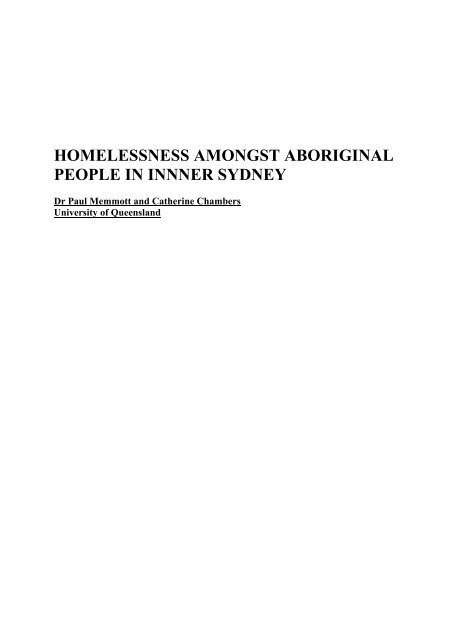

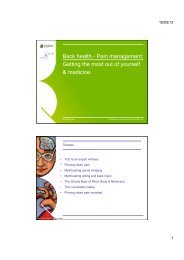
![Recycling [ PDF, 62KB ] - University of Queensland](https://img.yumpu.com/51805185/1/184x260/recycling-pdf-62kb-university-of-queensland.jpg?quality=85)
